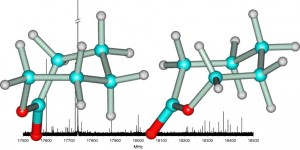Ribofuranose published
Category : New Results! Ring puckering
An article on ribofuranose appeared in Chemical Communications last April 1. In this work we explored the conformational properties of the biologically-active five-membered ring form of ribose using its rotational signature in a jet expansion. Previous studies in the gas phase and crystal structures had shown that the isolated molecule adopts a six-membered pyranose form, strikingly different to the biological use of ribose, as in RNA. Our spectroscopic information made possible a direct comparison of the observed gas phase preferences with the crystal structures.

In the figure above the two observed structures of methyl-beta-ribofuranoside and a diagram showing the puckering properties of the molecule (intramolecular hydrogen bond parameters in angstrom).


Recent Comments